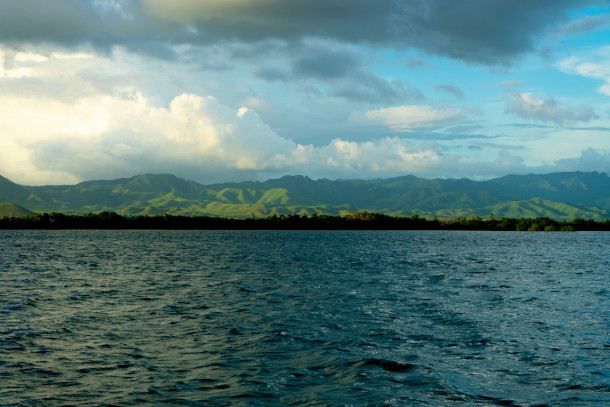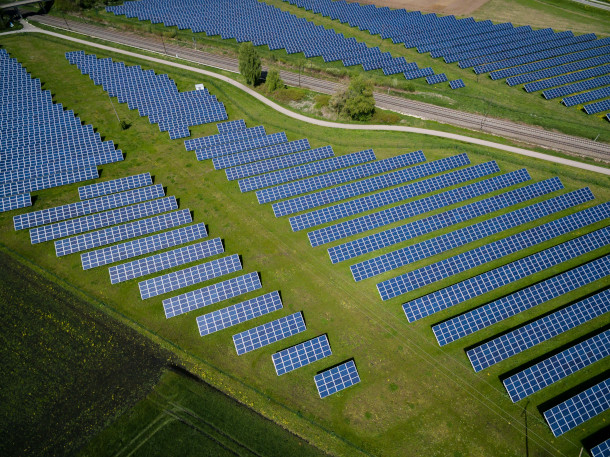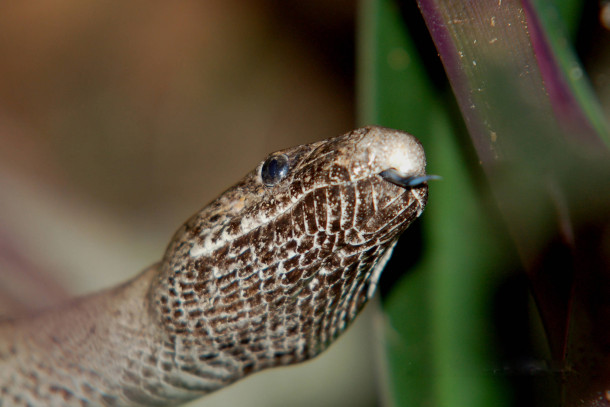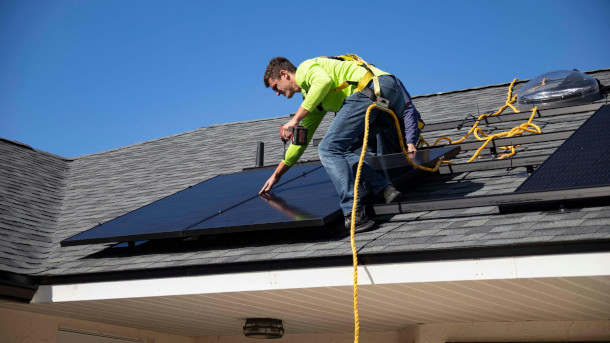Puerto Rico’s Solar Power Problem
Air Date: Week of November 15, 2024

A calm body of water in Salinas, Puerto Rico, with green mountains rising in the background under a bright, clear sky. The scene showcases the natural beauty of Puerto Rico’s southern coast. (Photo: Aaron Gonzalez, Unsplash)
After Hurricane Maria destroyed Puerto Rico’s power grid in 2017, much of the island was left without electricity for up to a year, leaving vulnerable populations in the lurch. Many Puerto Ricans are pushing for a reliable, sustainable electricity system, but a proposed utility-scale solar project has sparked concerns. Ruth Santiago, an environmental attorney who serves on the White House Environmental Justice Advisory Council, joins Host Paloma Beltran to discuss the future of solar energy in Puerto Rico.
Transcript
BELTRAN: In 2017, Hurricane Maria destroyed Puerto Rico’s power grid, leaving virtually all 3.4 million residents without electricity. Thousands of people died as a direct consequence of the hurricane, and those with health problems were left vulnerable due to a lack of refrigeration, dialysis care, food, and air conditioning, leading to even more deaths. The island has set a goal of using only renewable energy by 2050, and as it transitions away from the fossil fuels that currently supply 90% of its energy, reliability is a key concern. The Department of Energy recently announced an $860 million dollar loan for two industrial-scale solar projects meant to provide 200 megawatts of solar energy capacity yearly, enough to power 43,000 homes. This development, known as “Project Marahu,” is expected to be the largest solar and battery storage installation in Puerto Rico. The project will be led by Clean Flexible Energy LLC an indirect subsidiary of both the U.S.-based AES Corporation and Total Energies Holdings USA Incorporated. AES has been under scrutiny for its management of a 450-megawatt coal plant located in the south coast next to the communities of Salinas and Guayama. Ruth Santiago, an environmental attorney who lives in Salinas, is a member of the White House Environmental Justice Advisory Council, and board member of We Want Sun or Queremos Sol. She is here to share her concerns about this project and what she sees as the future of solar energy in Puerto Rico. Ruth, welcome back to Living on Earth!
SANTIAGO: Thank you. Hi, Paloma. Nice to be here again.
BELTRAN: Could you walk us through the details of the AES industrial scale solar project planned for Salinas and Guayama? What makes this project different from other solar initiatives?
SANTIAGO: Okay, so AES Corporation has a subsidiary and affiliate here in Puerto Rico, specifically in Guayama, Puerto Rico, here in southeastern PR, that runs a coal fired power plant since 2002. And they have been in violation of the Clean Air Act, the Clean Water Act, the Resource Conservation and Recovery Act with respect to the operation of the coal plant, because... Especially because of the mismanagement of the coal ash waste that the plant operates. And now AES is saying that they are going to close the coal plant. By law, they have to close by the end of 2027, and they want to build the largest solar installations in Puerto Rico, nearby their current operations, but also here in Salinas, extend into the neighboring municipality of Guayama.
BELTRAN: And can you describe to us the area of Salinas and Guayama, where this project will be located, who lives there and what kind of biodiversity can be found there?
SANTIAGO: The area is an agricultural area, also an area of huge ecologic value, very close to the Jobos Bay, and what is known as the Jobos Bay National Estuarine Research Reserve, designated by the National Oceanic and Atmospheric Administration, the federal agency known as NOAA. There's a combination of agricultural value, prime agricultural land, and also ecological value at this site. So pursuant to the studies that AES was required to do, they found that some of the areas where these proposed modules, it's like over 280,000 solar modules, that they are habitats for various protected species, like the yellow shouldered black bird, and for the Puerto Rican boa. It's local species of the boa, a snake, and also there is a species of lizards that are protected that were found in the area as well.

An industrial-scale solar plant in Offingen, Germany, with rows of solar panels covering the landscape, emphasizing the large-scale, industrial nature of the project. (Photo: Andreas Gücklhorn, Unsplash)
BELTRAN: So, there’s been a few studies monitoring how the AES solar projects will have a significant impact on local communities and ecosystems. Could you tell us more about that research, who has been involved in conducting these studies?
SANTIAGO: So, we have a couple of those. One of them is a hydrological study about the huge tract of land where the AES, what they call the Salina solar project, would be built. That's one of the studies, another study by a geologist indicates that the proposed projects are in seismic zone, active seismic zones. So, the only thing that divides this tract of land from the nearby community is a road. Directly south of that are some of the poorest communities with high poverty levels, high percentage of Afro descendant communities, formerly... A lot of former sugar cane workers and otherwise underserved communities lacking educational services, hospital and medical services. So, it's, in general, very vulnerable communities that are already exposed to some level of flooding. The Salinas, in general, is a highly flood prone area, right? And so, they do get some flooding now, that would increase with, you know, further construction, elimination of vegetation and stormwater discharges north of, of their areas.
BELTRAN: And, Ruth, you've form part of a coalition of organizations called Queremos Sol and advocate for solar energy in the island of Puerto Rico. To your knowledge, is there an area of the island that will be better fit for the type of project that AES is carrying forward right now?
SANTIAGO: According to most of the studies, really points towards using the built environment to place these solar panels, and there are lots of benefits to doing that. You don't sacrifice land, you don't sacrifice ecosystems, you don't expose nearby communities to more flooding. You increase the property values where these panels are sited. You actually protect the properties, and it allows for more energy security, right, when people have those panels on their rooftops or nearby in parking lots or in very close to the point of use, both for people and businesses and institutions. One of the other problems with these utility scale, industrial scale solar installations, is that they depend heavily on poles and towers and lines and wires and substations that are frequently impacted by hurricanes, by storms, by flooding, by vegetation growth, by wildlife impacts. So, energy generation that depends on transmission, especially like the solar arrays, have double vulnerability, let's say.

The Puerto Rico boa (Epicrates inornatus), an endangered species, inhabits the area where the solar project is planned, raising concerns about the impact of the development on this critical habitat. (Photo: Jan P. Zegarra, USFWS, Flickr, Public Domain)
BELTRAN: Now, of course, we've been talking about an industrial scale solar plant, but what are some examples of decentralized rooftop solar projects across the island?
SANTIAGO: So, the first that I know of was the Adjuntas Casa Pueblo in that town in the central, mountainous area of Puerto Rico, and it was, I think, the first initiative to branch out in that way. First, to start with their center, right, the Casa Pueblo headquarters or offices, and then branch out into nearby communities and small businesses, and then to their town center. And then, subsequently, other community environmental groups throughout Puerto Rico are doing the same, including here in Salinas and Guayama, where Comité Dialogo Ambiental and other groups are implementing rooftop solar projects, mostly for residential users.
BELTRAN: Now, looking at Puerto Rico's renewable energy goals, how do you envision a just transition? What would a fair approach to energy transition look like for communities in Puerto Rico?
SANTIAGO: Yeah, I think for communities, what's needed is a just transformation, because we need to consider things other than just carbon emissions or CO pollutant emissions. We need to consider resilience, for example, and on site, rooftop solar provides resilience that industrial scale solar projects can't provide. We saw after Hurricane Maria that the solar installations that existed at the time took about 15 months to be able to reconnect to the grid and generate at capacity, about 15 months without being able to supply energy to anyone. That would not happen if the energy were being provided by rooftop solar, obviously.
BELTRAN: So, Luma energy has been the primary energy distribution company in Puerto Rico for a few years now. What's been their relationship to renewable energy, or solar energy projects in the island?
SANTIAGO: They operate the transmission and distribution system, not the plants, although they do decide which plants sort of get to inject power into the grid. What Luma has done in terms of renewables is sort of conditionally approved integration of distributed renewable energy but charging people like extra for certain studies that are repetitive with respect to the linkage to, or interconnection with the system. But, because of these more frequent, more prolonged power outages, people who can afford it, higher income people, or people who have huge tolerance for high debt, have incurred, you know, and entered into these lease agreements that are like a second mortgage, is how people describe them. And of course, most of the population can’t afford that, right? So, right now, only about 8 or 9% of people, households, have rooftop solar with these private companies like Sonova, and the other 90+ percent is basically reliant on this centralized energy grid that fails frequently, whether through outages or with voltage fluctuations that damage household equipment, hospital equipment, etc.

Solar panels can be installed on rooftops, utilizing the built environment for clean energy generation without compromising valuable natural areas. (Picture: Raze Solar, on Unsplash)
BELTRAN: Now, looking ahead, what would you like to see from both the government and energy companies when it comes to supporting Puerto Rican communities in their advocacy for clean and equitable energy solutions?
SANTIAGO: The government, in order to facilitate an equitable system, right, is required, really, to use the historic amount of disaster recovery and mitigation funding that is over $19 billion, with a B, to provide real energy security and direct public funding for rooftop solar, energy efficiency, demand response, energy literacy programs, so that communities can become producers, not just passive consumers of energy, can provide at least their critical household needs, business needs, institutional needs, and continue to operate even after a big storm or hurricane. It's important to emphasize that like even just this year we had the storm Ernesto, and there was a power outage, and we heard about excess deaths again. And we really need to get the federal government and people in the states to get behind these agencies, the Department of Energy, the FEMA, the Army Corps of Engineers, to realize that Puerto Rico does not need to be a place of unmitigated disaster, that we can have a very viable electric system that provides energy security and allows for this to be a livable place, basically, where people can live and work and otherwise prosper.

Ruth Santiago is a community and environment lawyer, as well as a member of the White House Environmental Justice Advisory Council. (Photo: Courtesy of Ruth Santiago)
BELTRAN: Ruth Santiago is a community and environmental lawyer as well as a member of the White House Environmental Justice Advisory Council. Thank you so much for joining us.
SANTIAGO: Thank you. Thanks for the opportunity to be on with you in this conversation.
BELTRAN: We reached out multiple times to AES; the company developing the utility solar project and did not receive a response. A U.S. Department of Energy spokesperson did provide this statement: “As with all LPO (Loan Programs Office) projects that successfully close a loan, Project Marahu complies with the National Environmental Policy Act. This project will play an integral role in increasing Puerto Ricans’ access to reliable and affordable energy, while also creating jobs, improving grid reliability, and helping Puerto Rico reach its goal of 100% renewable energy by 2050.”
Links
Living on Earth wants to hear from you!
Living on Earth
62 Calef Highway, Suite 212
Lee, NH 03861
Telephone: 617-287-4121
E-mail: comments@loe.org
Newsletter [Click here]
Donate to Living on Earth!
Living on Earth is an independent media program and relies entirely on contributions from listeners and institutions supporting public service. Please donate now to preserve an independent environmental voice.
NewsletterLiving on Earth offers a weekly delivery of the show's rundown to your mailbox. Sign up for our newsletter today!
 Sailors For The Sea: Be the change you want to sea.
Sailors For The Sea: Be the change you want to sea.
 The Grantham Foundation for the Protection of the Environment: Committed to protecting and improving the health of the global environment.
The Grantham Foundation for the Protection of the Environment: Committed to protecting and improving the health of the global environment.
 Contribute to Living on Earth and receive, as our gift to you, an archival print of one of Mark Seth Lender's extraordinary wildlife photographs. Follow the link to see Mark's current collection of photographs.
Contribute to Living on Earth and receive, as our gift to you, an archival print of one of Mark Seth Lender's extraordinary wildlife photographs. Follow the link to see Mark's current collection of photographs.
 Buy a signed copy of Mark Seth Lender's book Smeagull the Seagull & support Living on Earth
Buy a signed copy of Mark Seth Lender's book Smeagull the Seagull & support Living on Earth

